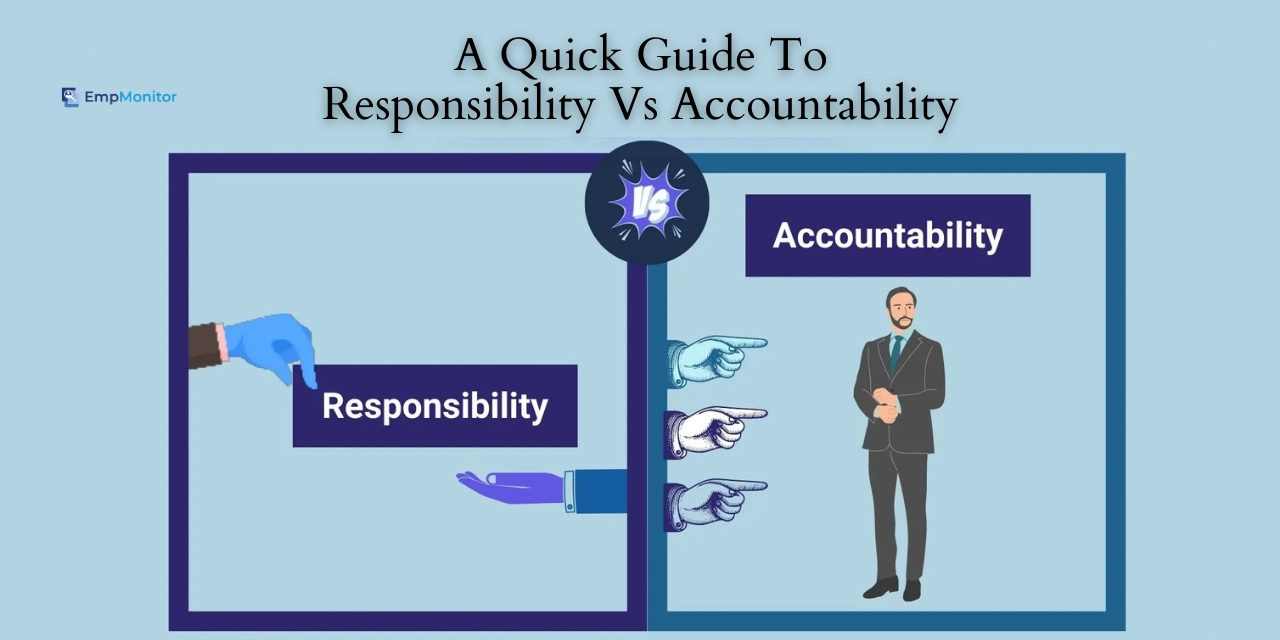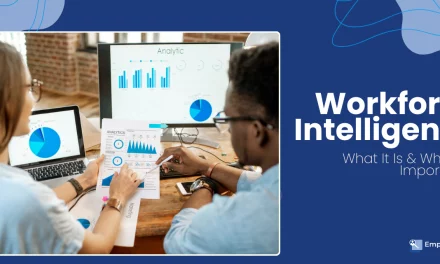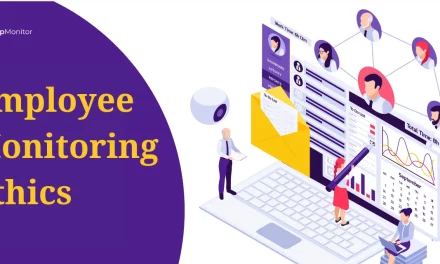As a manager, you might have essential deadlines emerging, and sometimes you’ll need to make quick decisions. In such a scenario, the terms responsibility vs accountability often overlap in the jargon of managers and leaders.
Consider a scenario where a project deadline is looming vast, and the team is racing against the clock to deliver results. The manager, tasked with overseeing the project’s success, assigns specific responsibilities to team members, delineating who is responsible for each crucial aspect. Let’s talk about being accountable: as the project goes on, unexpected problems come up, and the manager is responsible for making sure everything goes well, even when things get tough.
In this guide, we aim to unravel the fine distinctions of these two terms, shedding light on their distinct roles and offering practical insights for leaders and team members alike. From their meaning, key differences, and examples of the pitfalls and challenges, we have covered everything for you.
Listen To The Podcast Now!
Responsibility Vs Accountability – Decode Their Meaning
Responsibility and accountability, often used interchangeably, carry distinct significance in the professional realm. Responsibility refers to the detailed tasks and duties assigned to individuals within a team or organization. It is about fulfilling one’s obligations and executing assigned roles diligently.
In contrast, accountability extends beyond mere task completion. Therefore, it is essential to know how to boost team accountability. In a professional context, accountability involves being answerable for the consequences of one’s choices and actions. Depending on the context, it can be to superiors, colleagues, clients, or the broader community.
In the workplace, fostering a culture of accountability is crucial for promoting transparency, trust, and continuous improvement. While responsibility is about doing the job, accountability is answering for the results. It is necessary to understand the difference between responsibility and accountability for the implementation of effective leadership and teamwork.
Interplay Between Responsibility Vs Accountability
The interplay between responsibility and accountability creates a dynamic and symbiotic relationship within organizational dynamics. These two concepts, though related, serve distinct purposes, contributing to the overall effectiveness and success of teams and individuals. Let’s explore the nuanced interplay between responsibility and accountability.
Task Delegation
In task delegation, responsibility involves task delegation based on roles. Accountability often rests with higher organizational levels, ensuring oversight and alignment with strategic objectives.
Learning and Adaptability
Responsibility is learning, and adaptability consists of individuals learning within their specific roles. Accountability necessitates a comprehensive learning approach, fostering adaptability in the face of challenges.
Communication and Collaboration
Communication and collaboration are similar to responsibility vs accountability, which puts you at risk of getting stuck in a loop. Responsibility in communication requires effective communication within assigned tasks. Accountability emphasizes broader communication and collaboration to ensure the collective effort aligns with organizational goals.
Recognition and Trust-Building
When we talk about recognition and trust-building, then responsibility contributes to trust-building through the reliable execution of tasks. Accountability involves recognizing and rewarding those who take ownership and fostering a culture of trust and empowerment.
Proactive Problem-Solving
Responsibility focuses on solving problems within assigned tasks. On the other hand, accountability demands a proactive stance toward anticipating and addressing challenges at a broader organizational level.
In the arena of, organizational dynamics in terms of responsibility vs accountability, responsibility lays the groundwork for individual task completion, while accountability introduces the strategic and collective dimensions crucial for organizational triumph. Together, they form a dynamic interplay fostering collaboration, continuous improvement, and the realization of overarching goals.
Tips For Managers To Develop Responsibility and Accountability
Fostering responsibility and accountability within a team is integral to its success and productivity. Here are eight fruitful strategies for managers to cultivate these essential traits within their teams:
1. Clear Expectations
Clearly defining roles, responsibilities, and objectives is foundational. When team members understand their contributions and collective goals, they are more likely to take ownership of their tasks and exhibit accountability for outcomes.
2. Lead by Example
Managers serve as role models for their teams. By embodying the distinctive properties of responsibility vs accountability in their actions and decisions, they set the tone for responsible behavior and inspire their team members to follow suit.
3. Ownership Empowerment
Encouraging team members to take ownership of their work instills a sense of responsibility and pride. Empowered employees feel a deeper connection to their tasks, fostering a commitment to delivering high-quality results.
4. Feedback Culture and Report Analysis
Regular, constructive feedback and timely report analysis are essential in nurturing accountability. It helps managers to pinpoint and understand the strengths, areas for improvement, and the impact of the workforce activities, motivating them to take responsibility for their performance.
To leverage all these activities and streamline your workload without forgetting the rules of responsibility vs accountability, unfold your hands on EmpMonitor- employee monitoring software. A tool to better take care of your workforce.
EmpMonitor
EmpMonitor is an all-encompassing digital workforce tracking software crafted to assist managers and employers in monitoring the productivity levels of their staff, offering a complete 360-degree perspective on employee activities.
The software presents a multitude of features enabling employers to observe and track employee productivity to boost productivity rate conveniently, along with tracking their real location. The following outlines the key features of EmpMonitor:
1. Time Tracking
EmpMonitor provides robust time-tracking capabilities, allowing authorities to record and monitor employee work hours accurately. This feature goes beyond traditional clock-in/clock-out mechanisms by providing insights into the time spent on specific tasks or projects.
By offering detailed time-tracking reports, employers can gain a comprehensive understanding of how resource allocation takes place throughout the workday.
2. Productivity Analysis
The productivity analysis feature in EmpMonitor enables organizations to assess employee efficiency through meticulous activity tracking. Managers can count the software as an employee productivity tracker generating reports that delineate productive and non-productive hours, facilitating data-driven decisions to optimize workflow and resource allocation. This tool is invaluable for identifying trends and patterns in employee productivity to enhance overall operational efficiency.
3. Application and Website Monitoring
EmpMonitor extends its functionality by allowing employers to monitor and track employee internet activity usage of applications and websites during designated work hours. This feature provides a granular view of digital activities. It helps you identify the employee’s responsibility vs accountability difference and helps management identify potential distractions that may impact productivity.
Organizations must foster a better understanding of digital behavior to maintain a focused and efficient work environment.
4. Screenshots and Screen Recording
A noteworthy feature of EmpMonitor is its ability to capture screenshots or record screen activity for accountability and transparency. This functionality serves as a visual aid in understanding how employees navigate their tasks. The option for screen recording enhances this capability, providing an additional layer of detail for managers to review and offer constructive feedback based on real-time observations.
5. Attendance Management
In the realm of attendance management, EmpMonitor excels by providing tools to track employee attendance and punctuality. Automated attendance tracking simplifies payroll processes and ensures compliance with organizational policies. Detailed attendance reports empower HR departments with accurate data for payroll calculations and contribute to maintaining a well-regulated work environment.
6. Remote Work Monitoring
EmpMonitor accommodates the needs of remote teams by offering features tailored to track off-site work. As more organizations adopt flexible work arrangements, this functionality becomes essential to measure the responsibility vs accountability of the remote workforce. The tool ensures that remote employees remain productive and accountable, contributing to a seamless and fruitful remote work experience.
5. Open Communication
Creating an environment where open dialogue enables team members to voice concerns, seek help when needed, and take ownership of solutions. This open exchange fosters a culture of shared responsibility and problem-solving.
6. Consequence Clarity
A clear explanation of the consequences of actions, both positive and negative, helps individuals make informed decisions. Clarity on outcomes encourages team members to take ownership of their choices and be accountable for their results.
7. Support Growth
Investing in the growth and development of team members is crucial. By providing training, mentorship, and resources, individuals equipped with the skills and knowledge they need to fulfill their responsibilities. You gain a bonus point for your responsibility vs accountability ratio when you positively promote small changes to improve the workforce.
8. Celebrate Success
Recognize and celebrate achievements, whether individual or team-based, it reinforces a culture of accountability. It acknowledges efforts and contributions, motivating team members to maintain their level of responsibility.
By implementing these strategies and leveraging EmpMonitor, managers can create an environment where responsibility and accountability are valued and practiced. Enhanced productivity and performance, trust, collaboration, and a positive work environment are benefits of such a culture. When team members feel accountable for their work and decisions, they are more engaged, proactive, and aligned with the organization’s objectives, contributing to overall success and growth.
Read More
How To Boost Team Accountability In The Workplace
10 Reasons To Invest In An Employee Internet Activity Tracker
How To Boost Workforce Productivity Using GPS Employee Tracking
Challenges & Pitfalls Of Responsibility Vs Accountability
As a manager, you might have encountered challenges and difficulties while maintaining and implementing the system for responsibility vs accountability. Following are some of the common challenges and pitfalls.
Ambiguous Expectations
Confusing or unclear expectations can make it hard to understand roles and duties. It also stops individuals from taking charge of their tasks.
Lack of Communication
Challenge: Poor communication within a team can result in misunderstandings and missed deadlines. When there aren’t any good ways to share information, it’s hard to know who’s responsible for what.
Inadequate Training and Development
When workers don’t have training and chances to learn, they might not perform their jobs well, causing performance gaps.
Burnout and Overwhelm
Excessive workloads and unrealistic expectations can lead to burnout, reducing individuals’ capacity to fulfill their responsibilities effectively.
Wrapping Up
Responsibility vs accountability emerge as twin keystones, each lending its unique strength to the edifice of success. Personal responsibility requires a commitment to fulfill roles and obligations, recognizing the significance of each contribution. It forms the bedrock upon which collaborative endeavors stand.
However, responsibility itself can not sustain the structure. The responsibility for actions and decisions looms large, wrapped in the mantle of accountability. It transforms routine tasks into purposeful contributions, weaving depth into the responsibility. Together, they constitute a dynamic dance, adapting to the ever-shifting landscape of challenges, innovations, and collective growth.
As stewards in the delicate equilibrium of responsibility vs accountability, leaders bear the responsibility of nurturing a culture where these twin pillars flourish. In conclusion, the synergy of responsibility and accountability is not a burden but a set of wings propelling individuals and organizations to greater heights. Follow the guide mentioned above and EmpMonitor to attain the balance and streamline your management process.













